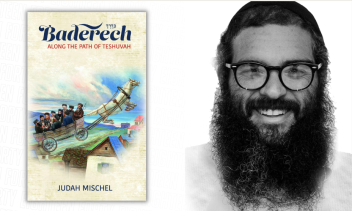It is teshuva time for the world, as we approach ourselves in the mirror and blink twice at what we find there. To help you come to terms with yourselves, and to avoid the hard work of change and therapy, we put together a history of teshuva, from the great before to today. Perhaps with the history of this journey in mind, we may walk forth with ever more confident footsteps, hopeful that we might too be better tomorrow than we were yesterday.
Pre-Creation
“Great is teshuva, for it predates the creation of the world,” an enigmatic Midrash (Tehillim 90:7) tell us, in a timeless statement. What might it mean, for teshuva to have existed before existence? If we see teshuva less as a defensive reaction to sin and more as a proactive gesture towards growing relationality, perhaps teshuva predates the creation of the world because the creation of the world is an offspring of the teshuva process of God, so to speak, in God’s desire to be a giver unto others, to live in relationship with others. Perhaps the world was created in an early movement of teshuva. Or perhaps not. That could also be the case. Let us know how you feel about this theory.
Biblical Era
In the heady days of the Biblical era, particularly as portrayed in Bereishit, the first book of the Torah, we bear witness to a stunning assortment of teshuvas big and small. Although we see many falls (Adam in the Garden, Cain killing Hevel, Esav being an overall rough dude, Yaakov being a trickster, Yehuda and Tamar, the tribes selling out their brother Yosef) we see far less in the way of rectification. The most powerful single moment in Biblical teshuva may be Yehuda’s acceptance of his wrongdoing, a powerful moment in which a public leader owned up to their wrongdoing, something many of our contemporary politicians might learn a thing or two from. Another powerful teshuva occurs later, when Yosef reconciles with his brothers in Egypt.
Although the Torah is sparse on the details of what became of some of the seeming-sinners, the sages later weave beautiful tapestries from the texts, finding in the textual gaps and hiccups hints to reconciliation that we see only blinks of in the text.
Prophetic Era
The books of the prophets can really only be described as a hot mess of teshuva. God and the Jews, and perhaps the whole world along with them, have a tumultuous relationship throughout Tanakh, with stints of love, anger, passionate reunion, and parting yet again. As Song of Songs so painfully and beautifully expresses, the relationship that a person or nation has with God (or with anyone, in truth) is resistant to easy interpretation or reductionism, and this comes through with power and poetry in the prophets. The deepest explications of the process by which we grow towards God emerge from this era, an era marked by a remarkable God-awareness, married to a constant struggle with God. But it is in this time that we learned that no matter what, the voice still echoes: “Return to me and I will return to you.” No matter what.
Talmudic Era
As mentioned before, the Torah is sometimes sparse about its sinners, which leaves a gap for the later sages to explore what may have happened later. While it is challenging to capture any one midrashic attitude to teshuva in this era, the midrashic lens helps us see the earlier world of the Torah through a more textured, layered reading. The literature written in this era tells us some lines of remarkable hope and compassion (“Even though one sins, they are a Jew”) and some more troubling lines about teshuva (“let all return … besides for Acher”). Yet in reading between the lines of the Torah, we read of the following afterstory to the Torah, and all else melts away. The Midrash (Bereishit Rabbah 22:13) sees two of the great sinners of the beginning of history, Adam and Cain, meet in encountering together the power of teshuva. Although in the Torah you don’t see either of them doing much of a teshuva, in the Midrash we read this:
‘And Cain went out from the presence of Ad-nai’ (Gen. 4:16) – from where did he go?! Rabbi Yudan in the name of Rabbi Ayvu said: he threw words behind him and went out, as one who could deceive the Highest Awareness. Rabbi Berachia in the name of Rabbi Eleazar son of Rabbi Shime’on said: he went out as one who shows the cloven hoof [a hypocrite] as one who deceives His Creator.
Harsh words! But then comes along Rabbi Chama and makes us smile:
Rabbi Chama in the name of Rabbi Chanina bar Rabbi Yitzchak said: he went out happy, as you read “behold he comes out to greet you [and when he sees you he’ll be glad in his heart]” (Ex. 4:14). Adam met him and said: ‘how did your judgement go?’ and he answered: ‘I repented [did teshuva] and I am reconciled.’ Adam began to hide his face [crying] and said: this is the power of teshuva [repentance] and I did not know. Immediately Adam rose and said: ‘A Psalm of Shabbat etc.’ (Ps. 92) Said Rabbi Levi: this mizmor was said by the first Adam and it was forgotten in his generation, and came Moshe and renewed it under his name, ‘it is a good thing to thank Ad-nai’ (Ps. 92:1-2).
Adam and Cain, learning about teshuva together. Thank goodness for the Midrash.
Medieval Era
In a pattern that roughly traces along much of Jewish history, medieval Jewish thinkers turned teshuva from a set of exhortations and guidelines in the Torah, Tanakh, and Talmud and created systems of repentance. From Rambam’s much-loved Hilchot Teshuva to Rabbeinu Yonah’s Sharei Teshuva, teshuva is now something more recognizable, and perhaps even quantifiable. R. Yehuda HaLevi’s Kuzari adds a philosophical weight to the movement, a movement of formalization that certainly echoes until this day.
Modern Era
Tshuva is interesting in the modern era. As the ghetto walls crumbled and industrialization set upon the world, new avenues for religious exploration opened up for religious Jews. As a result, many left religious Jewish life. Fascinatingly, a small number also returned from their new identities, birthing fascinating questions about reconversion rituals, a process by which some returnees to the faith attempted to utilize to reclaim their Judaism. In what might be a statement about how we all engage with our own religious choices, many Jews who left Judaism felt the need to mark their return with a reconversion, something not mandated by Jewish law or thought. Don’t we too sometimes desire to start afresh, to convert, or reconvert, or rerereconvert, when we return to ourselves?
Contemporary Era
With all of the questions and doubts that emerged from the 20th century and its refusal to sit still, teshuva becomes a movement. Heralded by towering people of heart such as R. Noach Weinberg, inspired by various itinerant preachers and singers, the 1970s and on were marked by significant numbers of people drifting towards Jerusalem, to a life of faith. As the 21st century enters, institutions for returnees to religious life abound, but so does the awareness of the increasingly broad nature of this complex word, teshuva, and the journey that we find ourselves on. Where will this path yet lead? Maybe we will get there on this road to teshuva—together.








